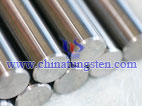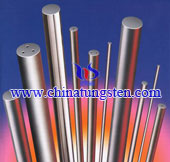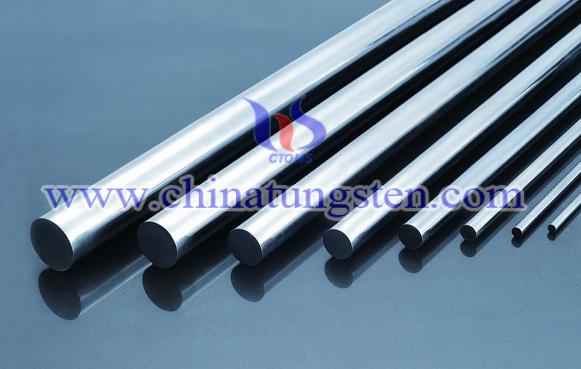Military Tungsten Alloy Swaging Rod & IDAS
- Details
- Category: Tungsten Information
- Published on Tuesday, 08 October 2013 18:29
- Hits: 1969
Military tungsten alloy swaging rod is made of tungsten alloy rod through calcinations. The normal method used in the processing are extruding, forging and sintering. After calcinations, tungsten alloy swaging rod has higher ductility, toughness and tensile strength than tungsten alloy rod, so it can be used for a longer time. Tungsten alloy swaging rod is widely used in military ares. Military tungsten alloy swaging rod can be used for IDAS.
IDAS is a short-range missile currently being developed for the new Type 212 submarine class of the German Navy.
IDAS (based on the IRIS-T air-to-air missile) is primarily targeted against air threats, such as ASW helicopters, but also against small or medium-sized surface vessels or coastal land targets. It is currently being developed by Diehl BGT Defence and HDW, which is a part of Thyssen-Krupp Marine Systems (TKMS), to be fired from Type 212's torpedo tubes. IDAS will be fibre-optic guided and officially has a range of approx. 20 km. Four missiles will fit in one torpedo tube, stored in a magazine. First deliveries of IDAS for the German Navy and operational service are planned from 2014 on.
The IDAS system is also the world's first missile which gives submarines the capability to engage air threats whilst submerged, and the first tube-launched missile that does not emerge in a capsule, but is fired directly from the torpedo tubes.
With the high density and hardness of military tungsten alloy swaging rod, IDAS can penetrate armor and destroy helicopter.

Tungsten Heavy Alloy Manufacturer & Supplier: Chinatungsten Online - http://www.tungsten-alloy.com
Tel.: 86 592 5129696; Fax: 86 592 5129797
Email: sales@chinatungsten.com
Tungsten & Molybdenum Information Bank: http://i.chinatungsten.com
Tungsten News & Tungsten Prices, 3G Version: http://3g.chinatungsten.com
Molybdenum News & Molybdenum Price: http://news.molybdenum.com.cn
Military Tungsten Alloy Swaging Rod & Tomahawk
- Details
- Category: Tungsten Information
- Published on Tuesday, 08 October 2013 18:21
- Hits: 1767
Military tungsten alloy swaging rod is made of tungsten alloy rod through calcinations. The normal method used in the processing are extruding, forging and sintering. After calcinations, tungsten alloy swaging rod has higher ductility, toughness and tensile strength than tungsten alloy rod, so it can be used for a longer time. Tungsten alloy swaging rod is widely used in military ares. Military tungsten alloy swaging rod can be used for Tomahawk.
The Tomahawk is a long-range, all-weather, subsonic cruise missile. The missile was named after the Native American axe. Introduced by General Dynamics in the 1970s, it was initially designed as a medium to long-range, low-altitude missile that could be launched from a surface platform. It has been improved several times and, due to corporate divestitures and acquisitions, is now made by Raytheon. Some Tomahawks were also manufactured by McDonnell Douglas (now Boeing Defense, Space & Security).
The Tomahawk missile family consists of a number of subsonic, jet engine-powered missiles designed to attack a variety of surface targets. Although a number of launch platforms have been deployed or envisaged, only sea (both surface ship and submarine) launched variants are currently in service. Tomahawk has a modular design, allowing a wide variety of warhead, guidance, and range capabilities.
With the high density and hardness of military tungsten alloy swaging rod, Tomahawk can penetrate armor and destroy warship.

Tungsten Heavy Alloy Manufacturer & Supplier: Chinatungsten Online - http://www.tungsten-alloy.com
Tel.: 86 592 5129696; Fax: 86 592 5129797
Email: sales@chinatungsten.com
Tungsten & Molybdenum Information Bank: http://i.chinatungsten.com
Tungsten News & Tungsten Prices, 3G Version: http://3g.chinatungsten.com
Molybdenum News & Molybdenum Price: http://news.molybdenum.com.cn
Military Tungsten Alloy Swaging Rod for Penguin Missile
- Details
- Category: Tungsten Information
- Published on Tuesday, 08 October 2013 18:06
- Hits: 1764
Military tungsten alloy swaging rod is made of tungsten alloy rod through calcinations. The normal method used in the processing are extruding, forging and sintering. After calcinations, tungsten alloy swaging rod has higher ductility, toughness and tensile strength than tungsten alloy rod, so it can be used for a longer time. Tungsten alloy swaging rod is widely used in military ares. Warhead of Penguin missile is made of military tungsten alloy swaging rod.
The Penguin missile is a Norwegian passive IR seeker-based short-to-medium range anti-ship guided missile, designed for naval use.
Penguin was originally developed in a collaboration between the Norwegian Defence Research Establishment starting in the early 1960s, with financial support from the USA and West Germany. US Navy test facilities and technical assistance were made available to facilitate development.It was the first NATO AShM with an IR seeker (instead of the commonly used active radar technology) and both hardware and software has been updated since entering series production in 1972.
With the high density and hardness of military tungsten alloy swaging rod, Penguin missile can penetrate armor and destroy warship.

Tungsten Heavy Alloy Manufacturer & Supplier: Chinatungsten Online - http://www.tungsten-alloy.com
Tel.: 86 592 5129696; Fax: 86 592 5129797
Email: sales@chinatungsten.com
Tungsten & Molybdenum Information Bank: http://i.chinatungsten.com
Tungsten News & Tungsten Prices, 3G Version: http://3g.chinatungsten.com
Molybdenum News & Molybdenum Price: http://news.molybdenum.com.cn
Military Tungsten Alloy Swaging Rod & AGM-123
- Details
- Category: Tungsten Information
- Published on Tuesday, 08 October 2013 18:14
- Hits: 1847
Military tungsten alloy swaging rod is made of tungsten alloy rod through calcinations. The normal method used in the processing are extruding, forging and sintering. After calcinations, tungsten alloy swaging rod has higher ductility, toughness and tensile strength than tungsten alloy rod, so it can be used for a longer time. Tungsten alloy swaging rod is widely used in military ares. Military tungsten alloy swaging rod can be used for AGM-123.
AGM-123 is a short-range laser-guided missile developed by the U.S. Navy.
AGM-123 is a short range missile intended for precision strikes. It is composed of a Mark 83 bomb, fitted with a Paveway kit, and an attached rocket propulsion system to allow it to be dropped at greater distances from the target. Tandem mounted Mk 78 solid propellant rockets which both fire simultaneously on launch provide propulsion.
With the high density and hardness of military tungsten alloy swaging rod, AGM-123 can penetrate armor and destroy warship.

Tungsten Heavy Alloy Manufacturer & Supplier: Chinatungsten Online - http://www.tungsten-alloy.com
Tel.: 86 592 5129696; Fax: 86 592 5129797
Email: sales@chinatungsten.com
Tungsten & Molybdenum Information Bank: http://i.chinatungsten.com
Tungsten News & Tungsten Prices, 3G Version: http://3g.chinatungsten.com
Molybdenum News & Molybdenum Price: http://news.molybdenum.com.cn
Military Tungsten Alloy Swaging Rod for AS.34 Kormoran
- Details
- Category: Tungsten Information
- Published on Tuesday, 08 October 2013 17:59
- Hits: 1877
Military tungsten alloy swaging rod is made of tungsten alloy rod through calcinations. The normal method used in the processing are extruding, forging and sintering. After calcinations, tungsten alloy swaging rod has higher ductility, toughness and tensile strength than tungsten alloy rod, so it can be used for a longer time. Tungsten alloy swaging rod is widely used in military ares. Warhead of AS.34 Kormoran is made of military tungsten alloy swaging rod.
The AS.34 Kormoran is a German-produced Anti-ship missile. The Kormoran (cormorant) uses an inertial guidance system for the midcourse phase, switching to active radar homing during the terminal attack phase. It carries a 165 kg (363 lb) delay-fused warhead, designed for 90mm of penetration prior to detonation. The maximum range is 23 km (~14 miles).
With the high density and hardness of military tungsten alloy swaging rod, AS.34 Kormoran can penetrate armor and destroy warship.

Tungsten Heavy Alloy Manufacturer & Supplier: Chinatungsten Online - http://www.tungsten-alloy.com
Tel.: 86 592 5129696; Fax: 86 592 5129797
Email: sales@chinatungsten.com
Tungsten & Molybdenum Information Bank: http://i.chinatungsten.com
Tungsten News & Tungsten Prices, 3G Version: http://3g.chinatungsten.com
Molybdenum News & Molybdenum Price: http://news.molybdenum.com.cn





 sales@chinatungsten.com
sales@chinatungsten.com